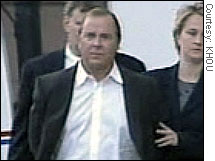|
Skilling takes a hike
AUG. 14, 2001
NEW YORK (FORTUNE) - The beginning of the end at Enron actually dates back almost four months before the company's bankruptcy filing -- to the day when Jeff Skilling publicly announced he was quitting as CEO. For many people, both inside and outside Enron, that was when it became clear something was seriously wrong at one of America's biggest companies. After all, men who have worked and schemed for years to reach the top don't just quit after six months on the job. Enron's stock fell 6 percent the next day, to $40.25. It would never close that high again. Aug. 14 will probably loom large at trial, as prosecutors challenge Skilling's longstanding claim that he was bolting entirely for "personal" reasons and had no idea Enron was on the brink of collapse. Despite later acknowledging that he was also rattled by the sinking share price (for Skilling, the value of the stock was personal), he has clung to that story, through a memorable 2002 public grilling by U.S. Senators until today.
But that's not all. At trial, his defense team will try to show that Skilling -- by many accounts a brilliant man who was calling the shots at Enron for years -- believed what he has so often said: that Enron was "in great shape" when he left. Prosecutors are likely to point to his abrupt departure and his sale of 500,000 Enron shares just a month later as signs that he knew the company was going down. Like Skilling, Ken Lay has presented himself publicly as both clueless and blameless. And like Skilling, he has insisted that, except for Fastow's criminal misdeeds, there was nothing really wrong at Enron. Those who knew Lay and Skilling at Enron have been struck by the irony of seeing them now marching in lockstep. The two men have never been close in business or temperamentally -- Lay cultivated a conspicuously self-effacing charm; Skilling proudly wore his bristling intelligence like a set of spikes. During Enron's glory years Skilling made little secret of his disdain for Lay, voicing his ultimate slight among colleagues: Ken just didn't "get it." The two men couldn't even manage the events surrounding Skilling's departure. While Lay publicly professed disappointment and shock at the news ("I certainly didn't expect it," he told reporters afterward), he had in fact known for weeks that Skilling was determined to go. And while Lay later claimed he did everything possible to get Skilling to change his mind, Skilling has told friends he was willing, if asked, to remain for six more months to ease the impact of his departure, but Lay made no effort to persuade him to stay. Of course, but for Skilling's resignation, Lay would never have reassumed his position as Enron's CEO, and he probably would not be facing a criminal trial. After all, Lay's indictment focuses on acts that occurred after he reassumed the role of CEO in August 2001. Prosecutors say that's when he took over the ongoing scheme to mislead the world about Enron, because he learned the company was in deep trouble ("Lay was briefed by numerous Enron employees on Enron's mounting and undisclosed financial and operational problems," according to Lay's indictment), and he was desperate to cover it up. It's hard to imagine that Lay doesn't blame Skilling for his current predicament. Skilling, in turn, has privately blamed Lay for failing to move decisively to save the company; as Enron spiraled downward, he unsuccessfully urged Lay to bring him back, arguing that he was the only man who could save the business. Their defense teams fought hard to have them tried separately. It will be riveting to watch these two peculiar bedfellows to see if any of the simmering tension breaks through the carefully composed picture of unity. Next: OCT. 24, 2001 Fastow becomes the enemy _______________________________ The former Enron chiefs fear a Houston trial may be their downfall -- full story here.
For all the latest headlines in Companies, click here. |
|

